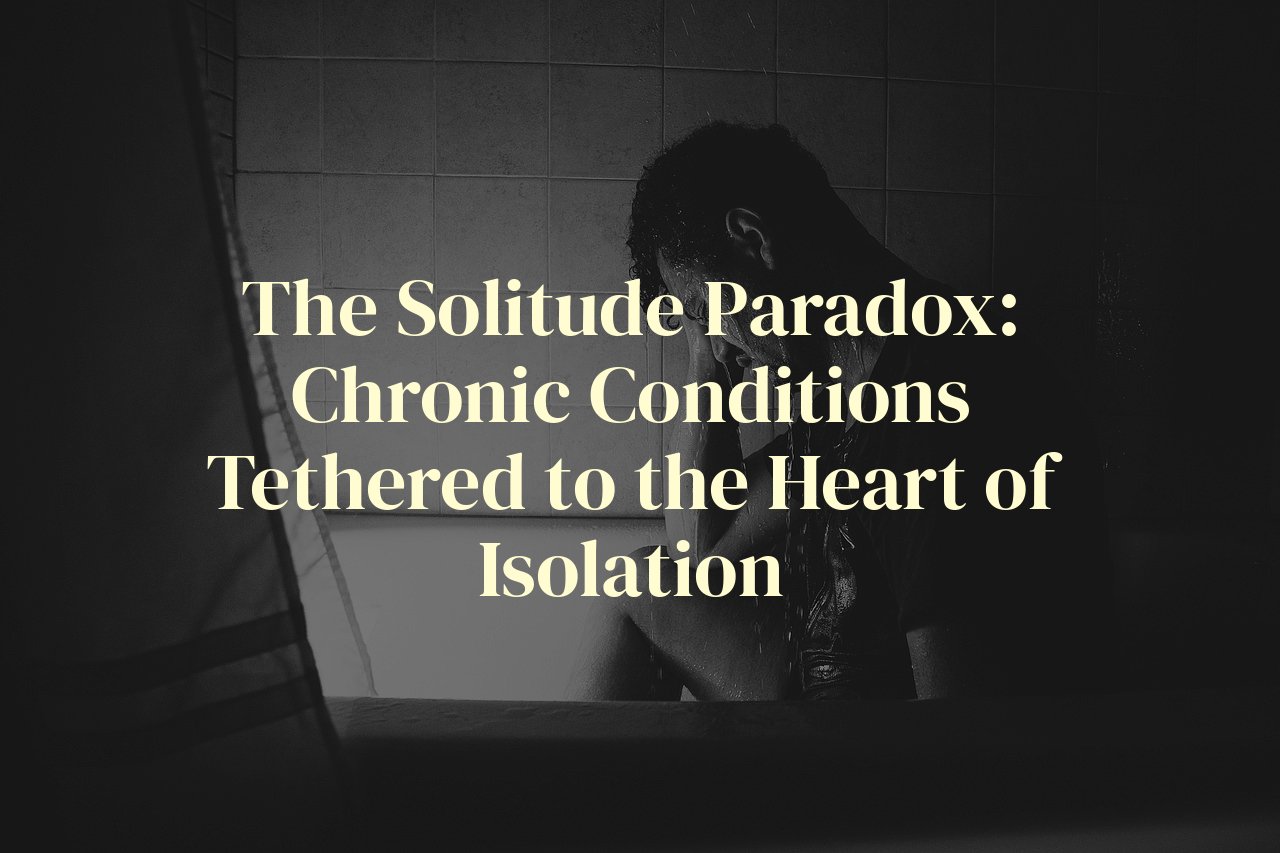
Delving into the profound intersection of solitude and chronic health, this exploration unveils the subtle yet significant ways in which loneliness engraves itself into the fabric of long-term illness. Within these passages lies a tapestry of case studies that not only portray the silent plight of secluded individuals but also highlight the embryonic hope for holistic healing beyond medication.
As we traverse through the veil of isolation, we uncover insights into the ripple effects of solitude on chronic disease management. Readers will glean an understanding of how interpersonal connections, or the lack thereof, act as an invisible player in the realm of chronic health. This blog post promises not just an eye-opener but also a heart-opener, showing ways to intertwine compassion with care.
Table of Contents
The Echo of Empty Spaces: Emotional Well-being and Chronic Illness
The interplay between solitude and chronic illness often goes unnoticed, yet it is as intricate as the most complex of weaves. In my years of exploring the deep-seated connections between emotional well-being and physical health, I’ve observed how the hush of an empty room intensifies the struggles of those with chronic conditions. Patients recount the heavy silence, not just with their voices, but with the weariness in their eyes, painting a vivid picture of their solitary battle.
In these empty spaces, the echoes aren’t merely sound bouncing off walls, but of the soul’s yearning for connection. This craving is often more than just a desire for company; it’s a lifeline to better health. Research supports this sentiment, indicating that emotional well-being is fundamentally tethered to the progression and management of chronic diseases. From diabetes to fibromyalgia, the tales are the same—those nurtured in nurturing environments seem to navigate their pathologies with a grace absent in those who tread their path alone.
The link is undeniably clear—loneliness can exacerbate symptoms, muddy the effectiveness of treatment plans, and even quicken disease progression. Moreover, this emotional strain can foster a dangerous feedback loop; chronic illness can be isolating, and isolation can in turn fuel the severity of the chronic illness. It’s a brutal cycle that begs for intervention. As a blogger who has witnessed the resilience of the human spirit, I’ve come to appreciate the stories of patients who engage with support groups, finding solace and improved health outcomes in shared experiences.
In the theater of chronic illness, emotional support is not merely an ancillary character but rather the co-star of the show. Mind-body therapy approaches, peer support networks, and even digital connectivity are proving to be potent allies in piercing the shroud of seclusion that often envelops those with long-term health conditions. Capturing these stories has been a journey, one that reveals the undeniable power of empathy and understanding in mitigating the trials faced by these silent warriors.
The echo of empty spaces resonates with a poignant truth: the heart and body are not separate entities but are deeply intertwined. It’s imperative that healthcare systems and personal networks strive for integrated care that places equal emphasis on emotional and physical health, understanding that the latter cannot truly flourish without the former. Chronic illness demands a chorus of support, not the solitude of a solo performance, and it is in this harmony that true healing can begin.
Companionship Versus Chronicity: Analyzing Relationship Dynamics
We often underestimate the profound influence that relationships can have on our health. Chronic diseases can be both a cause and effect of deteriorating companionship. I′ve seen individuals whose life stories reflect this complex interplay. Like a plot twist in their biographies, chronic illnesses often enter uninvited, and how one chooses to rewrite their existence around this uninvited guest speaks volumes about human resilience and the need for warmth of human relationships.
In analyzing these dynamics, it′s crucial to consider the role of a robust support system. Chronic conditions can fray the edges of even the most stalwart relationships. Case studies highlight individuals who found their social circles shrinking as their illnesses progressed; the constant care they required became an unintended barrier to nourishing, personal connections. Yet, conversely, there are stories of flourishing relationships that provided the emotional scaffolding necessary to cope with illness, indicating the reciprocal nature of social interactions and health.
Relationship dynamics often pivot on communication – the ability to articulate needs and listen empathetically. Patients with conditions such as diabetes or rheumatoid arthritis reported improvements in their physical well-being when they had partners or friends who participated actively in their care routines or simply offered an empathetic ear. The contrast with those suffering in silence, bereft of companionship, is stark, serving as a somber testimony to the health consequences of isolation.
The interdependence between companionship and chronicity reveals profound lessons. It teaches us about the social dimension of health, the necessity to foster connections not just for emotional fulfillment, but as a proactive strategy against the debilitating effects of chronic diseases. My work with patients has underscored an undeniable truth – that the medicine of companionship can sometimes rival the efficacy of pharmaceutical interventions. In the battle against chronic conditions, we cannot afford to ignore the therapeutic power of human connection.
The Invisible Impact: Blood Pressure and Heart Diseases Amidst Solitude
Emptiness often whispers the harshest truths about our well-being, a lesson I’ve personally grasped through a journey clouded by the shadows of solitude. Chronic heart diseases and elevated blood pressure, companions to my isolation, were not just medical conditions to be clinically treated. They were reflection mirrors, echoing the profound impact that a lack of human connection bears upon our most vital organ, the heart.
In the silence of my own sequestering, my health odyssey revealed an ‘Invisible Impact.’ Research has long concluded that social isolation can indeed exacerbate hypertension, leading to unwarranted stress responses. Solitary confinement, so to speak, became a catalyst for my sphygmomanometer’s higher readings. I learned that as human beings, our heart rhythms seek the dance of social synchronicity, and devoid of it, they can easily fall into erratic patterns.
Furthermore, isolation was found to aggravate existing heart conditions. An observation during the quieter days: each skipped beat was a Morse code missive, expressing a physical longing for communal bonds. Cardiovascular disease thrives in the absence of emotional warmth, its progress like vines climbing the walls of an abandoned castle. As I grappled with solitude, my heart bore the brunt of the battle, whispering the need for empathy every time it ached.
The link between loneliness and cardiovascular ailments isn’t simply metaphorical poetry; it’s a stern reality verified by numerous case studies. In the depths of my own lonesomeness, I was a living case study, one where dual diaries of the heart—physical and emotional—were penned in simultaneous sadness. As the palpitations grew, so did the realization that heart care is as much about harnessing human bonds as it is about managing cholesterol levels.
Though the road to recovery seemed daunting, this knowledge illuminated a path forward. It’s not enough to pop pills and adhere to dietary protocols; one must also nurture the heart’s invisible needs. Merging medical treatment with efforts to bridge the solitude divide holds the key to holistic cardiovascular health. As I walked this path, I found my blood pressure stabilizing, not just under the watchful eye of medication, but also under the tender gaze of renewed connections.
Digesting Desolation: Gastrointestinal Disorders Linked to Isolation
The intricate web of our body’s systems often intertwines our emotional state with physical health, casting a profound impact on how we process and experience illness. Particularly, gastrointestinal disorders manifest as a remarkable example of this phenomenon. As I empathetically wade through the murky waters of isolation, often disguised as a peaceful solace, the sharp pang of loneliness resonates within the depths of one’s gut, signaling a distress far beyond emotional pains.
Recent research has unmasked the surreptitious relationship between loneliness and the exacerbation of gastrointestinal issues. The sympathetic nervous system, which kicks into overdrive during periods of solitude, can disrupt the harmony of gut flora and instigate a series of inflammatory responses. It’s akin to watching the ripples from a stone thrown into the stillness of a lake; the solitude is the stone, and the gastrointestinal system is the surface of the tranquil waters being disturbed. As individuals navigate the solitude paradox, it’s not uncommon to witness an uptick in conditions such as irritable bowel syndrome (IBS) or gastritis, the effects of which I’ve observed with a sense of profound empathy in those around me.
Moreover, the role of stress hormones like cortisol further complicates the enigma comprising the gut-brain axis. They serve both as messengers and mischief-makers, heightening gut sensitivity and altering digestive processes. It’s a cacophony of sorts, where loneliness plays the somber tune that the body unwillingly dances to. In personal dialogues, I’ve heard the echo of discomfort and the wish for relief from people caught in this cycle of stress and physical disarray. Witnessing their struggle, it’s clear that the road to healing requires a bridge that connects not only bodily health but also emotional solace.
Addressing digestive despair, thus, mandates a holistic approach. Grounding oneself in practices such as mindfulness meditation or seeking support through community connections can have a soothing effect on the angry gut. It’s like a warm embrace to a friend in need or the soothing words whispered to calm a troubled sea within. Integrative nutritional strategies, too, play a pivotal role; adjusting one’s diet to include prebiotics, probiotics, and foods that reduce inflammation can nurture both the body and the mind’s well-being.
The journey through loneliness to a place of healing and understanding is intricate, often necessitating multiple conduits of support, and serves as a testament to the resilience of the human spirit. As a blogger deeply immersed in these experiences, I’ve witnessed transformations that fuse the sanctity of physical health with the nurturing presence of a community, crafting stories of recovery that transcend the bounds of medicine and touch the essence of human connectedness. After all, every human deserves to not just survive, but to thrive, beyond the shadows of isolation.
Bridging the Loneliness Gap: Integrative Approaches to Chronic Disease Care
The confluence of chronic illness and loneliness can create a daunting vortex for patients, one where the psychological burden can exacerbate physical symptoms, further anchoring them in isolation. As a healthcare blogger with a keen eye on dietary and emotional therapy, I’ve come to realize the powerful role integrative care plays in mending this rift. At the heart of bridging the loneliness gap lies the community-based support system, an essential scaffold that upholds patients both emotionally and physically. Witnessing patients thrive in a supportive environment has underscored the necessity of social inclusion in healthcare.
Personalized nutritional guidance, tailored to the needs of the lonely, serves not only their bodies but also provides an avenue for social interaction. Cooking classes and communal dining experiences are no less than a salve for the solitary soul, a place where shared meals foster a sense of belonging while nourishing the body. Through this perspective, food is more than sustenance; it’s a medium of connection, woven into the tapestry of community care.
Mindfulness and stress-reduction techniques, once considered auxiliary, now take center stage. Engaging patients in group sessions of yoga, meditation, or even simple breathwork crafts a common ground for human connection. Each exhalation becomes a silent language of empathy, each gentle stretch a communal journey away from isolation. These aren’t mere activities; they are a sanctuary for the solitary heart.
Telehealth initiatives, crucial during times when physical presence is scarce, have been pivotal in cultivating connections. What stands out is the beauty of a video call, the simplicity of seeing another’s face, feeling heard and cared for, even if through a screen. The digital realm, often berated for its coldness, transformed into a bridge over solitary waters.
Lastly, peer support groups harness lived experiences, creating bonds over shared struggles. Here, stories of individuals entwine, interlacing personal narratives with communal threads. It’s where vulnerability becomes strength, and the shared battle against chronic disease cements a camaraderie that defies the odds. It’s more than just exchanging tips; it’s the exchange of hopes, fears, and laughter amidst the backdrop of shared human experiences.
Conclusion
In summary, the threads of solitude weave complex patterns in the chronic disease domain. Through the prism of case studies examined, the shadow of loneliness casts a discernible influence over the progression and management of chronic illnesses. It becomes evident that healing transcends the prescription pad, beckoning a blend of community, empathy, and social support to counteract the silent affliction of isolation. Hence, we must tenderly nurture the social fabric encompassing our health, recognizing that even the faintest whisper of connection might echo resoundingly in the corridors of holistic well-being.



